
| "Stories are medicine. I have been taken with stories since I heard my first. They have such power; they do not require that we do, be, act anything -- we need only listen. The remedies for repair or reclamation of any lost psychic drive are contained in stories." ~ Clarissa Pinkola Estés in Women Who Run With the Wolves |
I'm a little late to this party -- two years to be exact -- but I have recently fallen in love with Once Upon a Time. Once again I tried to curl up with a little diversionary fluff and was instead abruptly pulled into the heart of the mysteries. As ever with these pop culture creations I am left to wonder if the writers are just randomly pulling these profound archetypes out of their deep subconscious, totally unaware of the implications, or if it's a carefully scripted foray into Gnosis.
The central plot is clever and entertaining. The evil queen from Snow White, she of the poison apple, takes her revenge by casting a spell that drags a myriad of fairy tale characters into a small town in Maine. There they live trapped in time and unable to remember who they really are. But the curse may be undone by the daughter of Snow White and Prince Charming, who was secreted out of the enchanted forest before the curse fell and predestined to return at the age of 28. Twenty-eight years later Emma Swan is living a lonely life in Boston until a young boy claiming to be the son she put up for adoption pulls her to Storybrooke. He insists she must fulfill her destiny and break the curse cast by his adoptive mother, who he is quite sure is the evil queen in his very unusual book of fairy tales.
Each episode weaves together the complimentary narratives of the characters' lives in Storybrooke and their history as fairy tale creatures. It's skillful, if somewhat predictable, storytelling. But it's in the imagery that the creators tip their hand. They speak the language of symbols far too well for me to take the series lightly. From the first episode I was struck by the subtle but brilliant use of sacred geometry, character names, and striking tableaux.
It is essentially a mystical story employing the most basic numerical code to appeal to conscious oneness.
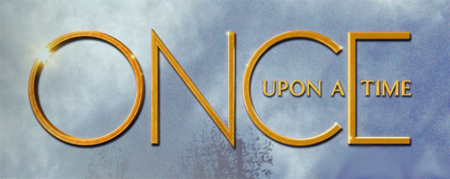
"Once" (one) dominates the graphic. "Upon a Time" is barely visible, reading almost like an afterthought. The O in Once is a perfect circle or monad. That basic form comes up again and again.
It appears in jewelry, like Emma's elegantly simple pendant:
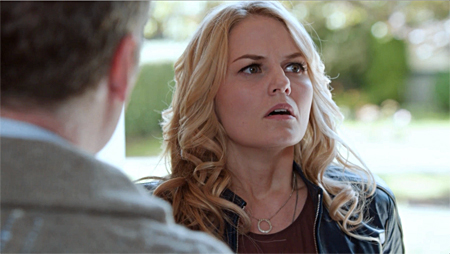
It appears in boldly outlined clocks like the one in the diner:

It appears in mirrors and windows like the one in the diner's kitchen door:
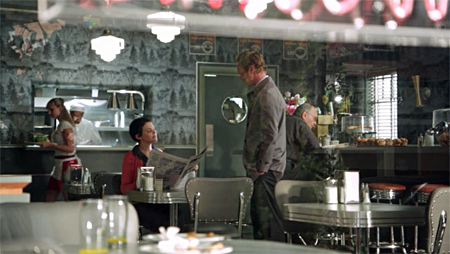
These perfect circles are subtle, woven seamlessly into the background, but they are ubiquitous throughout the first season as all of Storybrooke awaits the savior to wake them up from their illusory world. The inhabitants of Storybrooke have not just forgotten their fairy tale identities. Like the rest of us mere mortals, they have forgotten that they are part of the great oneness. The name Emma means "whole" or "universal." Her occult purpose is to remind them of what the Gnostics called the Pleroma or "fullness."
Emma's nemesis is the evil queen in her new guise as Storybrooke's mayor and Henry's adoptive mother. So to again put that in Gnostic terms, she is a ruler, or archon. Her function it is to keep humanity imprisoned in their false reality, asleep to the greater reality.
Queen Regina -- Regina means queen -- also wears a circular pendant. It is on prominent display when she crashes the wedding of Snow White and Prince Charming and informs them that she will be placing everyone under this dreadful curse. The pendant suggests, not just a circle, but a sphere or three dimensional circle. But it also suggests the murky, gray shroud that will envelope the bubble reality she is to create.

Within the reality of the show, Emma is special because she is the product of the true love of Snow White and Prince Charming. But such fairy tales aren't really about romantic love, which is why they fail miserably as relationship guides. Such ideal love represents the divine union which brings us back into wholeness. The wedding the evil queen crashes is symbolic, akin to the Chymical Wedding of Christian Rosenkreutz. A good explanation can be found here:
A "chemical wedding" does refer to an Alchemical process, it is, in fact the "central symbol of alchemy" according to the author of another book I came across while putting this talk together, entitled, "Alchemy" by Titus Burkhardt.
Our Most Excellent Captain Cliff, loaned me this one, and since it contains some background on the central theme of our story, I will quote from a chapter entitled, "of the Chemical Marriage". "The marriage of spirit and soul, (also referred to as) sulfur and quicksilver, sun and moon, or king and queen, is the central symbol of alchemy. Alchemy is based on the view that man, as a result of the loss of his original Adamic state, is divided within himself.
He regains his integral nature only when the two powers, whose discord has rendered him impotent, are again reconciled with one another. The regaining of the integral nature of man (which alchemy expresses by the symbol of the masculine-feminine androgyne) is the prerequisite - or from another point of view, the fruit of - the union with God."
The Author of the book, "Alchemy", Titus Burkhardt, continues by explaining the connection between marriage and death, "Closely related to the symbolism of marriage is that of death. According to some representations of the "chemical marriage" the king and queen, on marriage, are killed and buried together, only to rise again, rejuvenated. That this connection between marriage and death is in the nature of things, is indicated by the fact that according to ancient experience, a marriage in a dream means a death, and a death in a dream means a marriage. This correspondence is explained by the fact that any given union presupposes an extinction of the earlier, still undifferentiated state."
"Snow White and the Seven Dwarfs" is, of course, one of those tales in which the beloved dies, only to be resurrected. In the show both Snow and Charming experience these deaths and rebirths -- symbolic forays into the transformational power of truthful awareness.
They are wedded upon a perfect monad:
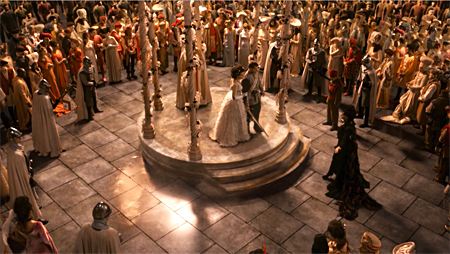
They are surrounded by coiling, DNA-like patterns on the stained glass windows:
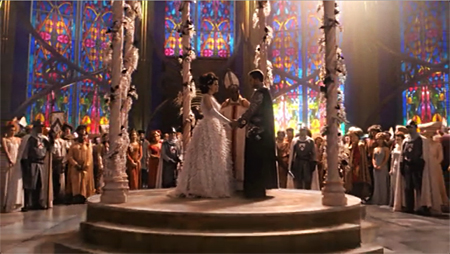
There's even a gratuitous circumpunct shot:
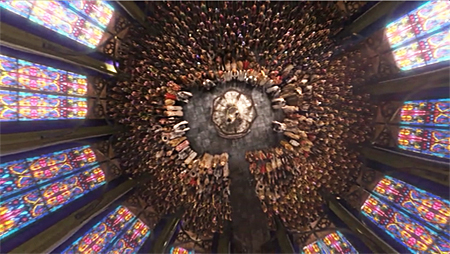
So Emma is the embodiment of the wholeness achieved by Snow White and Prince Charming, hence the name. But then she is orphaned and forced into a cold, cruel world -- our world. There she becomes Emma Swan. In Women Who Run With the Wolves, Clarissa Pinkola Estés positions "The Ugly Duckling" as the quintessential orphan/exile story. Perhaps this is what the writers are alluding to by naming her Swan. She, at once, symbolizes the wholeness, the Pleroma, and our collective exile from it.
Emma has been thrown out of the enchanted forest and into the wilderness. Kicked around the foster care system and surviving on her wits and petty crimes, the spark of divinity flickers quietly, directing her actions far more than she knows. On her 28th birthday -- 28 is right about when we start feeling the effects of our first Saturn Return -- her awakening begins in earnest. We see her in her apartment, with, funnily enough, a spell written on the outer door. The producers claim location scouts came across this door, as is, by happy coincidence.

Emma takes a single, round cupcake with snowy white frosting from a bakery box and inserts one candle decorated with a blue star -- blue like the blue pearl, blue like Snow White's bluebird companion. She lights the candle and makes her wish.
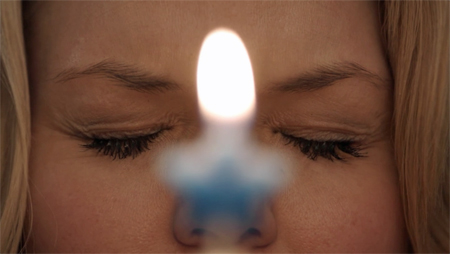
Her third eye has been opened. The awakening has begun and she looks like nothing so much as the Buddha Eye images found all over Nepal.
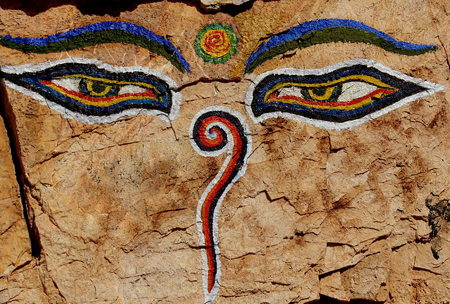
Moments later her biological son Henry -- or home ruler -- shows up at the door and her fairy tale odyssey begins.
As the clever back and forth between worlds plays out on the screen, we learn how Emma's hidden history brings her, inevitably, to the destiny that awaits her in Storybrooke. And we see her endure the painful process of awakening. In one scene we see Snow making plans to transport Emma beyond Regina's reach. She stands in a tower (spine) under a single disembodied eye.

In the next scene, having been run off the road by a wolf as she attempted to leave Storybrooke, Emma awakens to find herself in a jail cell. The camera closes in on a single eye as it slowly opens.
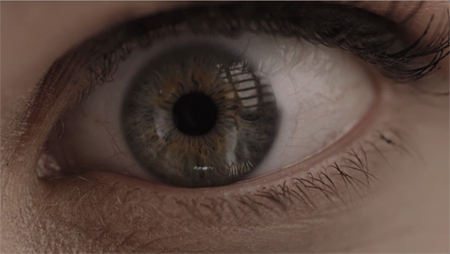
As a matter of pure symbolism, the soul's memory of wholeness is awakening the true self to the awareness that it has been imprisoned in an illusory world.
Meanwhile, the evil queen is also being rocked from her complacency. She is also awakening to the very real possibility that her spell can be broken. Note the position of her hands. They form an open eye, as she clutches the book of fairy tales that could be her undoing.

Emma's attempts to leave Storybrooke are repeatedly thwarted, as are Regina's attempts to make her go. Emma realizes that she must stay. She fears for the safety and mental health of her son, as he believes fairy tales are real is being raised by an unpleasant woman he thinks is an evil queen. Upon her decision, the broken clock in the clock tower, which represents the curse that holds them all frozen in time, begins to tick forward.
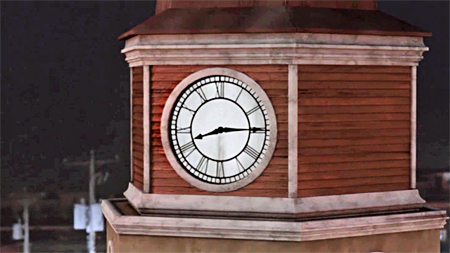
| "Time is regarded as a god by evil men who wish to hide the Essential Being...Vicious men think that Time is the cause of the world, but the wise and good think it is God." ~ C.G. Jung in Symbols of Transformation |
This is the beginning of the end of Regina's curse as Emma slowly awakens to the possibility that things might just be as Henry believes and ultimately fulfills her destiny.
As the residents of Storybrooke awaken from the curse, they naturally turn on their captor Regina.
"So I'm a prisoner now," whines Regina when she's imprisoned for imprisoning everyone in a tiny village from which they can't escape.

If you're a fan of Patrick McGoohan's The Prisoner, you can't miss the joke.
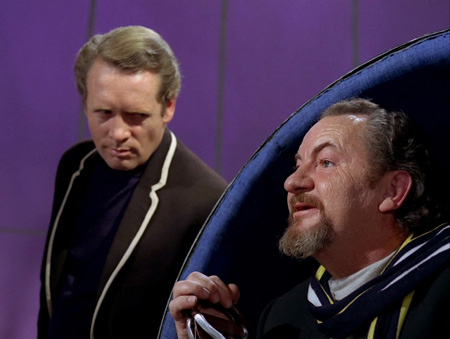
What we begin to discover is that Regina is not the real force behind this curse of forgetfulness. She has been made a pawn through appeals to her outsized ego. In psychological terms, Regina is a wounded narcissist, hence a mirror to forever adore her. She has been separated from her beloved by her toxic, heartless -- and heart stealing -- mother Cora. (Cora means heart.) She has been thwarted in both romantic love and divine union. Her own attempts to resurrect her dead lover go horribly, horribly wrong.
Narcissists, in a deeper sense, are thoroughly alienated from the experience of unity. Their understanding of the reflective world is truncated as they become trapped by their own reflection. While the mystical thinker understands that everyone he encounters is his reflection, he also understands that from the perspective of another, it is he who is the reflection. The narcissist only has a one way mirror.
Regina, furious that she can't control everyone and everything, has dragged them all into her fantasy and forced them to play the roles she's assigned them to. Once there she becomes frustrated that she can't make the unreal love her for real. She's built a playground that turns out to be just another lonely prison.
We learn from the very first episode that Regina may be the mayor (archon) but Mr. Gold "owns" the town. The real architect of the curse is that classic trickster Rumpelstiltskin.
In fairy tale lore, Rumpelstiltskin represents the hidden nature of the true self, slipping in and out of the shadows. His true name (identity) is a carefully guarded secret. He is also an alchemist with the ability to turn base matter into gold. He is the disowned remnant of our true nature and creative force (he steals babies) which we must uncover to achieve freedom from suffering. So it is only fitting that it would be Rumpelstiltskin who would fashion a spell to hide the true names and identities of all these mythic beings and set the stage for their redemption through the memory of oneness.
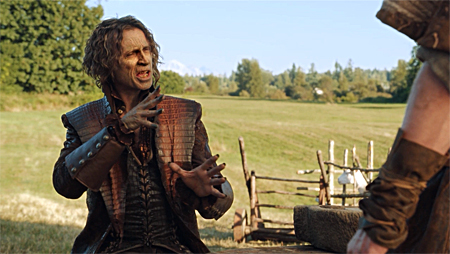
In Once Upon a Time, Rumpelstiltskin becomes the shadow that animates a multitude of fairy tale monsters and villains. He is the crocodile who stole Hook's hand. Note the jacket. He is the beast who wins Belle's heart. He embodies the darkness itself.
Rumpelstiltskin is given an origin story that explains his villainy and makes him easily the most complex and fascinating character in the series. It doesn't hurt that he's played by the brilliant and compelling Robert Carlyle. Rumpelstiltskin doesn't start out evil. Quite the contrary. He's a simple, sweet man -- a man who has so completely disowned his shadow that he's become weak and ineffectual. He is a man hobbled, literally, by his father's legacy of cowardice. After a lifetime of failure, Rumpelstiltskin's shadow finds him. He becomes the Dark One and learns to wield magic. In a broader sense, it's the path of power. Rumpelstiltskin must descend into the depths and win his power back by reclaiming the disowned shadow. Turns out it's a lot of shadow for one little man.
| "The ancients devised magic to compel fate. They needed it to determine outer fate. We need it to determine inner fate and to find the way that we are unable to conceive. For a long time I considered what type of magic this would have to be. And in the end I found nothing. Whoever cannot find it within himself should become an apprentice, and so I took myself off to a far country where a great magician lived, of whose reputation I had heard." ~ Carl Jung in The Red Book |
"Rumpelstiltskin" is what Estés would characterize as a "poor bargain" myth, akin to "The Handless Maiden." In that story, a father, also a miller, accidentally trades away his daughter to the devil for the promise of wealth. Writes Estés:
So, the tale begins with the unintended but acute betrayal of the young feminine, of the innocent. It can be said that the father, who symbolizes the function of the psyche that is supposed to guide us in the outer world, is, in fact, very ignorant about how the outer world and the inner world work in tandem. When the fathering function of the psyche fails to have knowing about issues of soul, we are easily betrayed. The father does not realize one of the most basic things that mediates between the world of the soul and the world of matter -- that is, that many things that present themselves to us are not as they seem upon first contact.
Where Regina represents the broken heart of motherlessness, Rumpelstiltskin represents fatherlessness. It's the failing or absent fathering that leaves the child with instincts too damaged to successfully manage material survival and manifestation. This sad legacy he also unwittingly passes on to his son.
He also represents the shadow journey the injured soul must take to restore strength and resourcefulness and bring us back into wholeness. Rumpelstiltskin, as Beast, is really very evenly matched by Belle. She also was traded away in a poor bargain by her failing father. One of the things we realize about Belle, when she is trapped in her Storybrooke guise and becomes Lacey, is that she is also wrestling with her disowned shadow. It was never as simple as Beauty seeing the underlying goodness in the accursed Beast. She was pulled first to his darkness. Like most good girls, Belle can't resist a bad boy. As Lacey, she directly expresses her darkness as a trashy barfly. When Gold tries to charm her with the goodness he thinks Belle fell in love with, Lacey is so bored she ditches him for an ordinary lout. Only when she sees the depths of his darkness does he evince interest.
None of us can return to the state of conscious oneness without reclaiming the shadow. Only through that marriage of opposites can we achieve the alchemical union, the true love, that brings us back into that perfect circle.
Just as the visual elements of the cursed Storybrooke use the geometry of the monad to recall the state of oneness, the fairy tale realm explores the architecture of matter with more complex geometries.
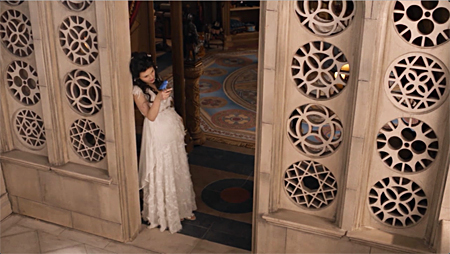
In the second season, after Emma has lifted the curse, we see a growing repertoire of sacred geometry in both worlds.
In one marvelous bit of playfulness, we see a flashback to Emma's earlier incarceration in juvie. A perfectly wrought vesica piscis can be seen in the window, over the guard's shoulder.
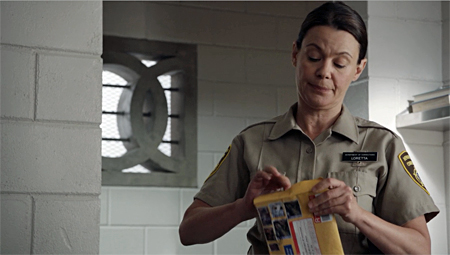
It foreshadows beautifully her opening eye in the Storybrooke jail cell some ten years later. But it is also artfully picked up in the very next scene, where a painting of interlocking spheres adorns a wall in Snow White's apartment, seen over Charming's shoulder.
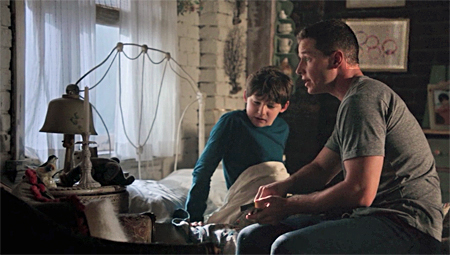
The use of symbolic geometries is incredibly deft. When we get a better look at the book of spells Rumpelstiltskin passes from Cora to Regina, we learn first that it is adorned with the all-important heart, surrounded by a rich tangle of Celtic knots.

When Regina opens the book we see a beautiful use of the mystical seven -- the elusive heptagon.

Michael Schneider explains the complexities of sevenness in A Beginner's Guide to Constructing the Universe. It is an ethereal number, not a material one. It is not born in the normal way and does not give birth to number.
A regular heptagon cannot be constructed with the geometer's three tools and so is not born like other shapes through the vesica piscis.
. . .
The ancients referred to seven as the "virgin" number. It is untouched by other numbers in the sense that no number less than seven divides or enters into it, as two divides four, six, eight, and ten, three divides six, and nine, four divides eight, and five divides ten. Seven was also considered childless since it produces no other number (by multiplication) within the ten, as two produces four, six, and so forth.
It is the number of pure spirit, the divine mystery behind the material world.
Seven has always predominated in mythology, mysticism, magic ceremony, and superstition (both lucky and unlucky). Its appeal endures to this day in religion, nursery rhymes, and folk sayings, from the reverent "seven angels before the throne" to the colloquial "seven year itch." Our feel for sevenness is a measure of our sensitivity to the archetypal heptad.
Eight, by contrast is "promiscuous" writes Schneider. The enchanted forest is the domain of core archetypes, closer to matrixic reality than our world. It is akin to the non-ordinary reality encountered by the shaman -- the reality behind this one. It is a place of pattern formation and promiscuous eight is a number of material manifestation. Eight mediates between spirit and matter. So, in the enchanted forest, octagonal forms abound.

The well that serves as a portal between the enchanted forest and this world is naturally octagonal.
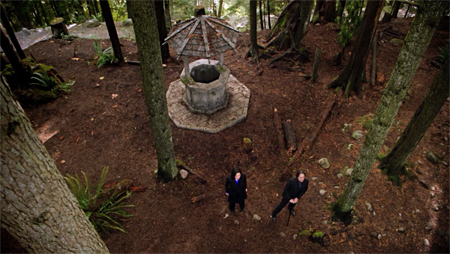
Eight is the number of spider who spun the great web in which the world was formed. And web images are suddenly everywhere in the second season. Emma's fascination with dreamcatchers is the most explicit. But there are also many subtler visual allusions, like the patterns in floors:
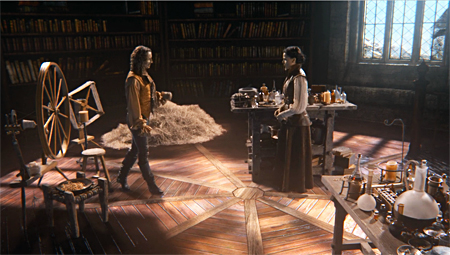
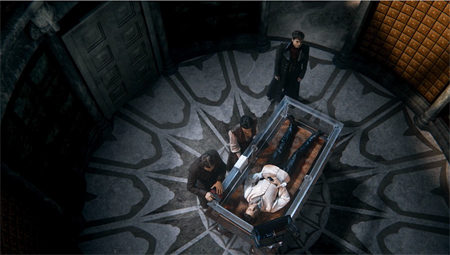
And Lacey's shirt:
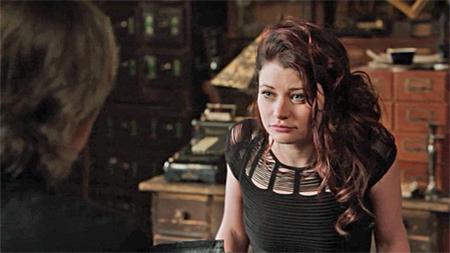
Beyond dreamcatchers and other allusions to grandmother spider, there are many nods to shamanic cultures. The Mad Hatter, for instance, is an opener of heads. His hats, we learn, are really portals into other worlds, Wonderland being one.
There is also a lot of interplay with animal spirits. Snow White holds wild birds in her hands like pets. An otherworldly wolf makes a number of appearances, operating as a companion, guardian, and guide. He's an ethereal, silvery white with one red eye -- like Odin's remaining solar eye -- and one black eye.
Red Riding Hood, as it turns out, really does run with the wolves. She's a werewolf, or therianthrope. The red cloak, in this telling, is enchanted and prevents her lunar transformation, because when she transforms she murders the local villagers and has no memory of having done so.
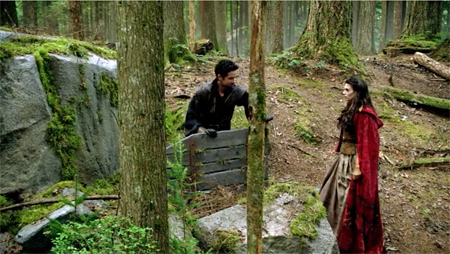
An episode called "Child of the Moon" explores Red's back story in greater depth. In this flashback she finds the mother she thought dead and an entire clan of werewolves. She is no longer an orphan. She has found her people. From her mother she learns that if she allows rather than fights her shapeshifting transformation, she will remain conscious throughout and control her actions during her nocturnal journey. She doesn't have to be an out of control killer. She can reclaim her authentic wildness and live with the natural dignity of a wolf. But the red robe of her Grandmother had robbed her of her wildness and rendered her feral.
In "The Red Shoes" Estés explores the feral nature of the orphan who, left to her own devices in the natural setting of the forest, raises herself quite capably. It is only when she is "rescued" by an oppressive matriarch and forced to live in a civilized manner, detached from nature and her own instincts, that she becomes feral, reckless, and self-destructive.
I postulate the feral woman as one who was once in a natural psychic state -- that is, in her rightful wild mind -- then later captured by whatever turn of events, thereby becoming overly domesticated and deadened to proper instincts. When she has opportunity to return to her original wildish nature, she too easily steps into all manner of traps and poisons. Because her cycles and protective systems have been tampered with, she is at risk in what used to be her natural wild state. No longer wary and alert, she easily becomes prey.

This is the ongoing struggle of Red Riding Hood, or Storybrooke's Ruby. She is torn between her authentic nature and the civilizing Granny who, with the best of intentions, suppresses and warps her natural instincts.
Red finds that the rift between her shafeshifting tribe and the civilized world is too great. They are effectively at war with one another. Red is forced to choose between the wild life she has found and her love for what is good and true within the civilized world. She has little choice but to kill the mother and become an orphan trapped between the worlds again. This is the turmoil that has followed her to Storybrooke where in her Ruby identity she continues to live in conflict between the oppressively civilizing Granny and her wild nature. She is, however, able to keep the lesson of her people -- that if she doesn't resist the call of the wild when it comes, she can remain conscious throughout it and navigate the night as a wolf instead of a monster. And she is able to bury and properly grieve her mother.
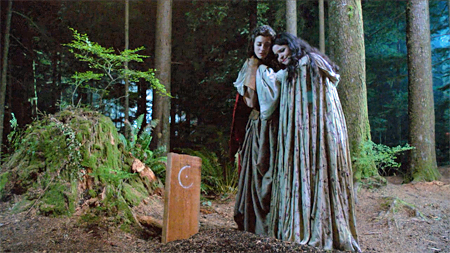
In a broader sense, these stories also speak to the collective struggle between modern civilization and the indigenous peoples whose lives in harmony with nature and the spirit world have been subject to cultural -- and literal -- genocide. And it speaks to the challenges of the urban shaman in reclaiming the soul's connection to the spirit world.
Rumpelstiltskin, aka. Mr. Gold, is not a shaman but a dark sorcerer. The basic tool kit is the same. It's the intent that's warped. In the same episode, he explains to young Henry that he has wandered into a place in the spirit world that exists between life and death as an after-effect of a sleeping curse. It's a room of fire where he encounters another survivor of a sleeping curse, Sleeping Beauty. He has found a bridge between Storybrooke and the enchanted forest where Emma and Snow White have become trapped. If he could master the transit through this world, he could potentially help them. Gold explains:
When people fall under a sleeping curse, their soul travels to a netherworld where it resides until they're woken. Now this world is between life and death. And it's very real. However, even when the curse is broken, sometimes in sleep, the victims find their way back into that world -- victims like you.... Once you control the journey, fear will stop. And then you can come and go as you please.
He gives Henry an amulet filled with a potion that will allow him to remain conscious and in control during his sleep journey. The lunar symbol on it is identical to the one on the mother wolf's grave.
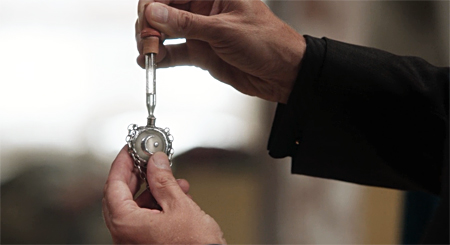
This is what the shaman does. He travels in and out of the spirit world consciously and with clear intent. He navigates cleanly between the worlds. And sometimes he shifts into the shapes of power animals.
Often, the shaman uses a tree as an entry point into non-ordinary reality. Trees are one of the world's oldest religions. So it only makes sense that a tree forms the portal through which the infant Emma could escape Regina's curse. Geppetto, that clever worker of wood, turned an enchanted tree into a wardrobe to another world -- not Narnia, this world.
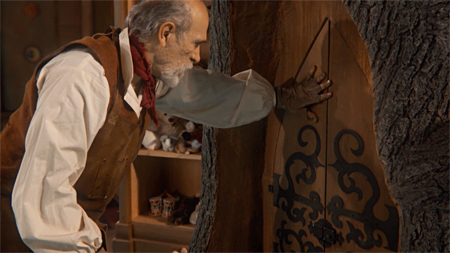
The mythic significance of Emma's tree escape becomes even harder to ignore when we see the "enchanted" tree.

Could they have found a more Yggdrasil looking tree?
Many shamanic cultures of the world divide the universe in three different planes or worlds, which are connected by a world axis (or something similar to it). In many of this cosmologies there is also a cosmic snake or dragon playing an important part. We will also find this tripartite in the nordic mythology which is passed unto us.
Mythic trees figure rather heavily into the plotting of the show. Regina's magical "honeycrisp" apple tree also weaves between the worlds, producing enchanting apples, and finding its way onto the Storybrooke seal.

That cosmic serpent also winds through the plotting and imagery. There are multiple allusions to kundalini mythos. Young Henry chooses the name Operation Cobra for the clandestine plan to awaken Storybrooke and free it from his adoptive mother. When Henry's life is in danger, Emma descends to the depths of the earth to face a dragon and retrieve the power hidden in a golden egg. But the most explicit visual reference occurs with the murder of Snow White's father, King Leopold, as two vipers are unleashed on his sleeping form and slither up alongside him under the blankets.
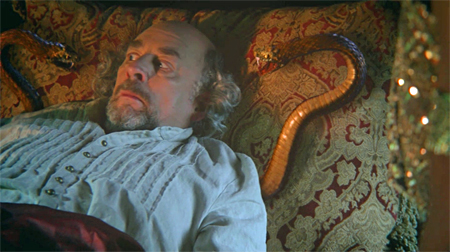
They simultaneously strike him on either side of neck, creating a rather perfect image of the caduceus.

The good King Leopold is in divine union, fully awakened, and joining his true beloved Snow White's mother in the afterlife. Snow and Charming are in divine union, so much so that Rumpelstiltskin steals their hair to make a most powerful of potions. It also coils like a DNA pattern in the glass.
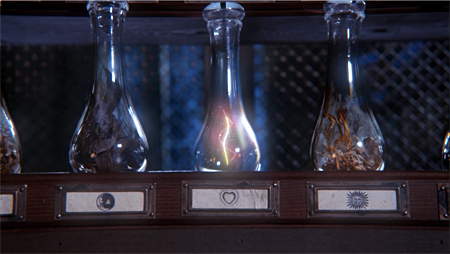
Rumpelstiltskin and Regina represent failed attempts at alchemical union. Rumpelstiltskin's wife leaves him. He finds true love with Cora but she chooses wealth and power instead. Belle falls in love with him but he is too attached to the power of the darkness to let her fully awaken him. Regina's true love dies and cannot be restored. But Emma's embodiment of wholeness brings hope and redemption.
Emma has also experienced an alchemical union with Neal (champion) Cassidy (clever) and this unites the very opposite Snow White and Rumpelstiltskin lines. Neal, as it turns out, is Rumpelstiltskin's long lost son Baelfire, a name I have little doubt refers to the Bale Fire of Beltane. The term traces back to the Old English bael pyr or fyr which actually means funeral fire. So we once again have the merging of blessed union and funeral of the Chymical Wedding. Their union is also symbolized by the alchemical gold of a classic yellow Volkswagon -- and that is one imperishable car. Classic bugs are durable but this one has remained in mint condition through some pretty rough years.
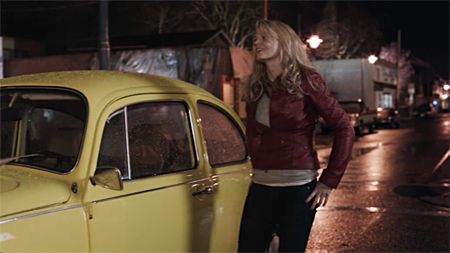
And it results in the birth of the "truest believer" Henry.
Ultimately, Once Upon a Time is about waking up to the call of the soul. It kindles the wildish nature of Clarissa Pinkola Estés's vision. It presses up against the bars of the jail cell that imprisons our divine spark. And it points us toward the seat of divine union: the heart.
| "Fairy tales, myths, and stories provide understandings which sharpen our sight so that we can pick out and pick up the path left by the wildish nature. The instruction found in story reassures us that the path has not run out, but still leads women deeper, and more deeply still, into their own knowing. The tracks we all are following are those of the wild and innate instinctual Self." ~ Clarissa Pinkola Estés in Women Who Run With the Wolves |

You have an amazing ability to 'connect the dots'.
ReplyDeleteI would have missed most of these 'dots' you have connected since I know next to nothing about mythology and sacred geometry... I would have just been carried by the story and imagery like a child.
I don't have much of a formal education - I basically stopped going to school in the 7th grade. By the time 9th grade rolled around I had been made a 'ward of the court', for truant/runaway stuff, and sent to a Catholic 'home for wayward girls'. I officially dropped out of school in the 10th grade.
I do read a lot and I'm pretty good at crossword puzzles, but whenever I try to analyze shit and use my intellect to make a decision or a choice it does not turn out well. My instincts serve me much better and I have always had more success 'flying by the seat of my pants'.
And that is another reason I did not care for Women/Wolves... it seemed to be all about analyzing and interpreting the 'artwork' of life and then applying that intellectual understanding, based on somebody else's interpretations, back on the instinctual self as therapy. And like I said elsewhere - trees make the best therapists. Gardening is great therapy too. That has been my experience anyway.
Still, I am totally and absolutely impressed with your keen observations and your ability to put them into such cohesive, crystal clear context. And I love your taste in music too, hahahaha!
"I would have missed most of these 'dots' you have connected since I know next to nothing about mythology and sacred geometry... I would have just been carried by the story and imagery like a child."
ReplyDeleteNothin' wrong with that, zigzag. As Estes says, the stories themselves are medicine. (Or in the case of some stories, like The Giving Tree, poison.) So much of this speaks directly to the subconscious. And for all I know, it was derived entirely from the subconscious. For all I know the writers have no interest in alchemy, sacred geometry, or myth. That's the thing about archetypes. We know them even if we don't know them. I just tend to think they must know something because it's just so laden with imagery and its use is so coherent. Of course, if you a deep interest in fairy tales, you're already immersed in myth and the writers are definitely fairy tale lovers.
I know for a fact that the symbolism in Harry Potter, another one that can be thoroughly enjoyed at the level of story, is very conscious. J.K. Rowling is extremely well-versed in Western Alchemy and has been fairly public about that.
What's more interesting to me is that there seems to have been a dramatic uptick in the use of this symbolism in television and film. I thought it might be just a case of my being more dialed in, in more recent years. But I watch older movies and shows, old favorites, and even when it's there, it's not as prominent or pervasive. I really think there's some sort of shift happening, probably at the level of the collective unconscious. I'm just having my mind blown every time I turn on my television.
"Nothin' wrong with that, zigzag. As Estes says, the stories themselves are medicine. (Or in the case of some stories, like The Giving Tree, poison.)"
ReplyDeleteYeah, I'm VERY careful about what I read or watch... I like to be entertained not poisoned!
And definitely there is a shift happening. I think we have reached critical mass, or soon will... it wasn't all that long ago this kind of awareness had to be hidden from your neighbors unless you wanted to be ostracized from the community at best, or worse thrown into insane asylums or even burned alive. Now you can find it EVERYWHERE you look.Yeah, a shift is happening alright. I really believe it has already happened.
Oh, one other thing I wanted to say, on instincts. This is one thing I've learned the hard way, more than once, more than twice... If my intellect and my intuition agree, great. If not, go with intuition, even if it makes not a lick of sense. My intuition has proved out more times than I can count and when I've second-guessed it too much, I've paid the price.
ReplyDeleteThe thing is, that's whatWomen Who Run is about. It's about recovering and healing the instinctual nature. Most of us, growing up in a world that disparages instinct and intuition, have injured instincts. Particularly as women, because we've collectively suffered so much abuse -- emotionally, sexually, and on every level, our drives have been thwarted and turned against us. It happens with men, too, and I've recommended this book to male clients in some cases. I've known both men and women, for instance, to wear "the red shoes" -- feralness as opposed to wildness. But for women it's profound and systemic.
"Oh, one other thing I wanted to say, on instincts. This is one thing I've learned the hard way, more than once, more than twice... If my intellect and my intuition agree, great. If not, go with intuition, even if it makes not a lick of sense. My intuition has proved out more times than I can count and when I've second-guessed it too much, I've paid the price."
ReplyDeleteHahaha... a few years ago I bragged to my sister "I've finally learned to listen to my inner voice." Then, not even 3 days later, I was sewing curtains for my son's room. They were black velvet and of course I was using black thread. As I was getting ready to sew them a little voice in the back of my head said "Measure twice, sew once". I answered back "nah, my measurements are accurate" and proceeded to sew not one row of stitching but two very close together rows of stitching, and with the smallest stitch that I could possibly use. It took me more than a week of unfuckingbelievably TEDIOUS work to get that stitching back out!
I love red shoes!!! And to my understanding, the only difference between feral and wild is that wild was born that way and feral was once domesticated but has reverted to wild. What's wrong with that??
The problem is that the feral have injured instincts. Much of what we think is our instinct, when we're in that state, is just reckless impulse and can lead to further injury. We're not in touch with our core. Results are things like addictive behaviors. One of the examples Estes points to is Janis Joplin. The tricky thing about intuition is that we can call something intuition that is really just a really strong ego want and deceive ourselves. We can end up chasing fantasy instead of vision. That's how Estes interprets "The Red Shoes," which, as you probably know, is a story about a girl whose shoes dance her to her death.
ReplyDeleteAnd, for the record, I applaud that you can sew, period. It's a talent I lack and it's something that can only be learned in part. I can sew buttons back on and tuck things. It pretty much ends there. You know those poor illiterate kids that teachers pass with a D just because they never want to see them again? That was my seventh grade sewing teacher. I think she was just really afraid that I was going irreparably break a sewing machine. It was a fair concern.
ReplyDeleteReckless impulse in an attempt to compensate for injured instinct. Hahahaha... I wonder why that sounds so familiar to me?
ReplyDeleteAnd no, I don't remember ever hearing the story of the girl whose shoes danced her to death, although now that you mention it sounds vaguely familiar... I thought you were referring to Red Riding Hood in OUAT.
Not only can I sew but I baked my first loaf of sourdough bread from scratch today, hahaha!
Well, that's the thing. The Red Riding Hood character in OUAT seems to allude -- rather strongly -- to The Red Shoes. She's at war with her impulses and her grandmother is constantly trying to rein her in, in good, reasonable ways, and in unintentionally soul crushing ways. It's only when she reclaims her wildish nature that she can reclaim her instincts without being run by her impulses and, you know, killing people. It's actually very well drawn.
ReplyDeleteI've always been able to cook. That's one talent I definitely do have. I don't do breads because I can't eat wheat and yeasts and I are touch and go. So your sour dough, while delicious I'm sure, is right out for me. But I was an A student in my eighth grade cooking class. Now that teacher loved me.
The reason I thought it was Red Riding Hood you were referring to was because I thought I saw her standing there in red shorts and red high heels, but I just went back up and looked and it's red shorts and a red jacket, not red high heels... her feet are pretty much cut off in the photo. And oh yay, I never killed anybody so maybe there's hope for me after all! I'm looking forward to watching that series.
ReplyDeleteI don't eat a lot of wheat myself, but sometimes I want a tuna sandwich or a pizza (with goat cheese, garlic and spinach - yum!) and I just don't trust store bought breads (or pizza crusts). I think fermented dough is more easily digested and less problematic.
I wonder why your school taught sewing before they taught cooking?? Seems like it should be the other way around.
I wonder why my school did a lot of things the way they did. That was pretty minor, in the grand scheme.
ReplyDeleteI have been keeping a pretty much nocturnal schedule these days, and this fun conversation with you kept me up waaay past my bedtime (which is usually right around noon). I went to bed shortly after my last post, which was around 6:30pm and I got up at 1am.
ReplyDeleteI headed out for my 'midnight' walk (with my cats trailing along behind - you'd think they were dogs the way they love going for walks with me), and found myself thinking about a book I used to own called "Why the Reckless Survive", which is another book that I really loved the title of but couldn't muster up enough interest to finish reading. It seemed like the book was written by a psychiatrist or something, and I hate psychiatrists.
The guy who wrote it is Melvin Konner and I just read that he is a Professor of Anthropology and of Neuroscience and Behavioral Biology. I went to his website and read this blog entry:
http://www.melvinkonner.com/index.php?option=com_wordpress&p=677&Itemid=72#more-677
What do you think? I enjoyed the read so much that I might have to give 'Why the Reckless Survive' another chance too (along with Estes' book).
My kitty just came and informed that it's raining outside (my favorite weather!!) so I will have to go out and enjoy it before I tend to such domestic tasks as mopping floors and rearranging my computer area, hahaha.
"In the bad old days in India, when widows of Hindu men were burned to death on their husbands’ funeral pyres, that was not because their dead husbands hated them, although it might as well have been."
ReplyDeleteUm, yeah! It still goes on, btw. It's called Sati, or Sutee. It's illegal, but there are still instances of it happening little villages here and there. Horrible.
Good article. I'm not familiar with the book or the author, but when a book calls, pick it up. I only read books as they call to me. I have books that are years old that I haven't read yet because it wasn't time. I know it will be some day so I keep them.
I agree... but did the book call to me or was it just dredged up from my memory by your mentioning reckless impulse? Like having a picnic one day and then dreaming about a picnic that night.
ReplyDeleteI'll probably go ahead and get it though because I really like the cover. Then there's this bit from a NY Times reviewer: "Konner proposes that our rationality evolved in a world where seat-of-the-pants problem-solving sufficed. If you made it past the saber-toothed tiger safely and found a bush of ripe berries, you had done well." Gee, what a coincidence... I just used that seat of the pants phrase in this conversation! And for sure I've made it past a few saber tooth tigers and found plenty of berries. Oh well, we'll see... if it suddenly turns up on my doorstep I'll definitely read it.
Gavin de Becker, Gift of Fear, says that our instincts have served us through thousands of years of evolution. I'm a big believer in trusting instincts and intuition. As I said, I've learned it hard.
ReplyDeleteWhen I've bought books in bookstores, I've often picked them up and felt in my body whether they're right or not. So even when it comes to cerebral pursuits, I think my gut has served me well. It's harder with internet bookstores. Dowsing helps.
Hey zigzag, I thought this was something of a synchronicity.
ReplyDeletehttp://celestial-reflections.blogspot.com/2014/07/cafe_29.html
I have sat down to respond to this 2 or 3 times since yesterday and been pulled away from my computer every time... I have been very busy!
ReplyDeleteHowever, I wasn't interested in any of those radio shows. I'm not into any kind of religion (don't let my username fool you), my kids are grown, and I don't care whether aliens walk among us or not, hehe. I AM interested in watching OUAT though... which I just got season 1,2 and 3!!! I'm gonna have an episode watching marathon tonight! I think I'll even make popcorn, hahaha!
Aliens? Okay, that took me a minute. I see what you mean now. No. I was just talking about Christina's show on getting back to the authentic self. Just thought it was an interesting synchronicity, as we were just discussing the red shoes.
ReplyDeleteI hope you enjoy the show. Mmmm..... popcorn....